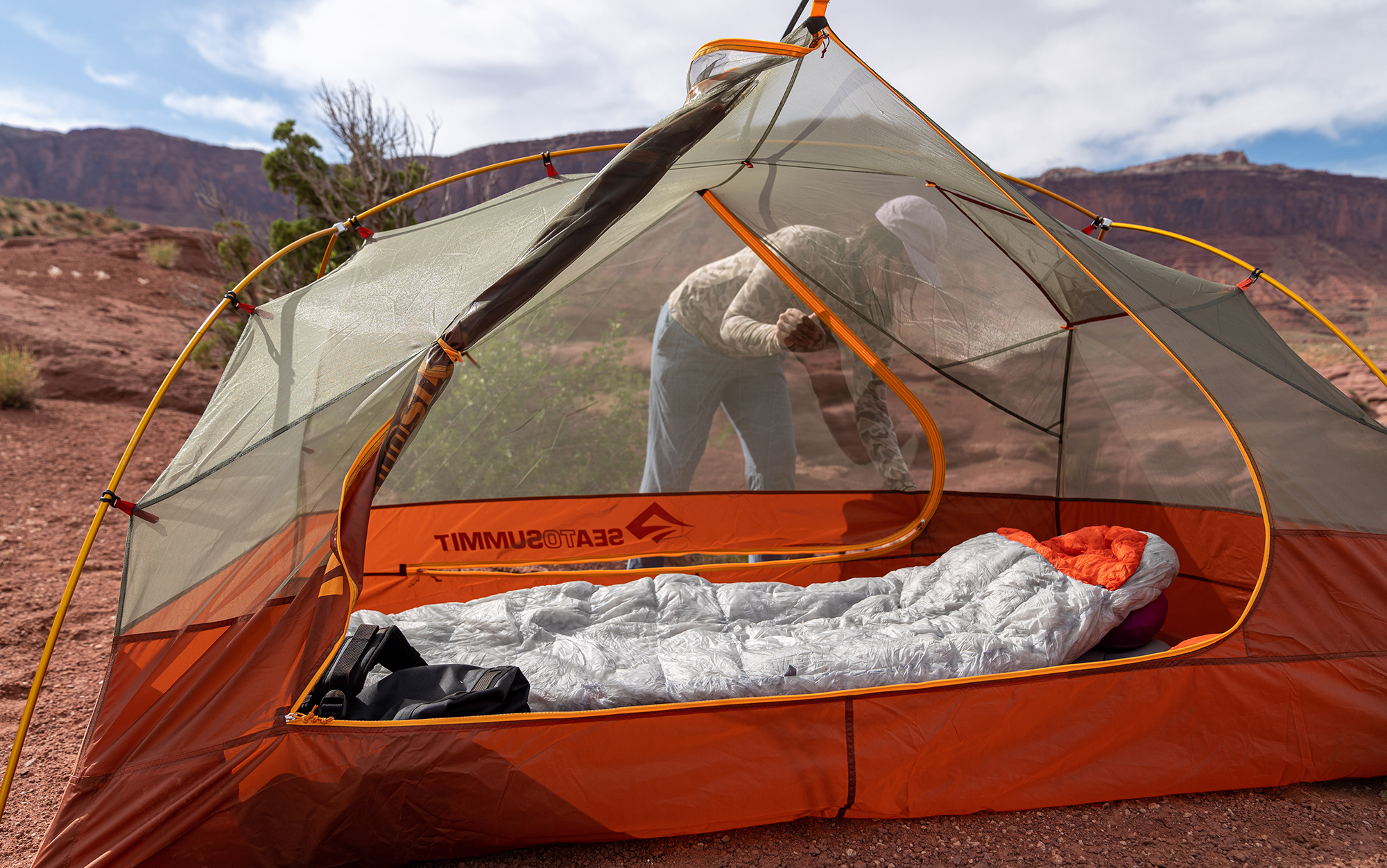We may earn revenue from the products available on this page and participate in affiliate programs. Learn More ›
Your backpacking sleeping bag is a crucial part of your sleep system, and usually the largest item in your pack. Selecting the right one depends on the temperature range and moisture levels where you hike, your backpacking style ranging from traditional to ultralight, your sleeping habits, and your budget. We tested all of the bags on this list in the field to give you a better idea of which backpacking sleeping bag is best for you.
Best Down: Therm-a-Rest Parsec
↓ Jump to Review
Best Budget Down: Kelty Cosmic Down
↓ Jump to Review
Best Synthetic: Nemo Forte Endless Promise
↓ Jump to Review
Best Budget Synthetic: Marmot Trestles
↓ Jump to Review
Best Deluxe: Western Mountaineering AlpinLite
↓ Jump to Review
Best Ultralight: Feathered Friends Egret
↓ Jump to Review
Most Durable: Mountain Hardwear Yawn Patrol
↓ Jump to Review
Best for Side Sleepers: Nemo Disco
↓ Jump to Review
Best for Cold Weather: Stone Glacier Chilkoot
↓ Jump to Review
Big Agnes Roxy Ann 3N1
↓ Jump to Review
Best for Babies and Toddlers: Morrison Outdoors Little Mo 20
↓ Jump to Review
How We Tested the Best Backpacking Sleeping Bags
OL staff writer Laura Lancaster and I tested the best backpacking sleeping bags in the field to determine which are best suited to varying conditions, sleeping habits, and backpacking kits. I also loaned these bags to friends with varying levels of backpacking experience and noted their feedback, as everyone sleeps differently and prioritizes different features.
If you’re new to backpacking, it’s hard to tell what you’ll want in a sleeping bag. We delve into the details of each bag to help you formulate an idea of what your perfect bag is. There are also some technical specs that should weigh heavily in your decision; find out more in the How to Choose section below.
Even veteran backpackers typically don’t get the chance to test out a sleeping bag before they buy it. Our descriptions should give you invaluable insight into the advantages and disadvantages of some of the most popular sleeping bags on the market.
Best Backpacking Sleeping Bags: Reviews & Recommendations
Best Down: Therm-a-Rest Parsec
Buy the Parsec
Key Features
- Sizes: Small, regular, and long
- Temperature Ratings: 0, 20, and 32 degrees
- Weight: 1 pound, 12 ounces (regular 20 degrees)
- Packed Size: 7 x 8.5 inches in diameter
- 800 fp Nikwax hydrophobic RDS-certified goose down
Pros
- Ultralight
- High fill
- Packs down small
- Stash pocket
- Included compression sack
Cons
- Only unzips on one side
- No vents
- Not very roomy
This bag looks like a man-sized beehive thanks to its horizontal baffles and bright yellow hue. It’s also my favorite sleeping bag I’ve ever used. Therm-a-rest’s Parsec uses 800fp hydrophobic down to create an ultra puffy and warm sleeping bag that feels like crawling into a hug after a long day on trail. It’s also sub 2-pounds and disappears in my pack. I don’t use a compression sack for my sleeping bag; instead I stuff it in last or near last so that it takes up any empty space in my bag. The Parsec is particularly suited for this packing style as it simply disappears around all my other gear. It’s a wonder to behold.
One of the drawbacks to this bag is that it isn’t very roomy. But to me, this means no pockets of cold air for me to accidentally disturb in the middle of the night. If I sleep on my side, I simply rotate the bag with my body instead of trying to turn inside the bag. If this sounds similar to your sleeping style, you’ll love the Parsec. It only unzips on one side, but at 1 pound, 12 ounces, it’s hard to care. One place Therm-a-rest didn’t skimp for weight is the phone pocket on the right side, which is one of my must-haves. It’s like this bag was made for me, and it’s lightweight and high-fill makes it the best overall backpacking sleeping bag. —Ashley Thess
Best Budget Down: Kelty Cosmic Down
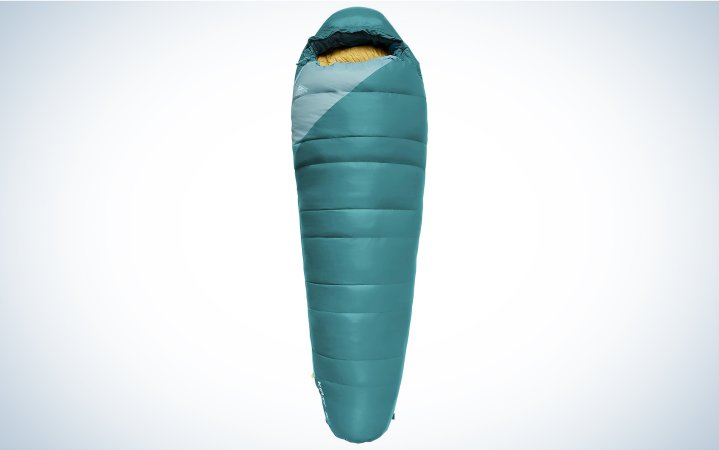
Buy the Cosmic Down
Key Features
- Sizes: Short, regular, and long in men’s and women’s
- Temperature Ratings: 0, 20, and 40 degrees
- Weight: 2 pounds, 8 ounces (men’s regular 20 degrees)
- Packed Size: 13 x 7 inches in diameter
- Uses 550 fp duck down
Pros
- Affordable (especially for a down bag)
Cons
- Mummy shape is less comfortable than other sleeping bag shapes
- Bulky for a down sleeping bag
- Heavy for a down sleeping bag
Down sleeping bags can get pretty pricey, especially if the bag in question is using a high-fill power down (thinking 700 fp or greater). The Kelty Cosmic Down is the exception. It uses a 550 fill power down that brings the cost down in line with synthetic backpacking sleeping bags, without sacrificing the insulation that you need to stay warm overnight.
Of course, there are some tradeoffs. First: This bag is pretty heavy — too heavy for most backpackers. It’s also on the bulky side for a down bag, closer to what you would expect from a high-quality synthetic sleeping bag. Finally, the classic mummy shape is pretty constrictive. If you sleep directly on your back without moving, then you’ll be fine. Side sleepers, stomach sleepers, fidgeters — expect to wake up at least once feeling claustrophobic. —Laura Lancaster
Best Synthetic: Nemo Forte Endless Promise
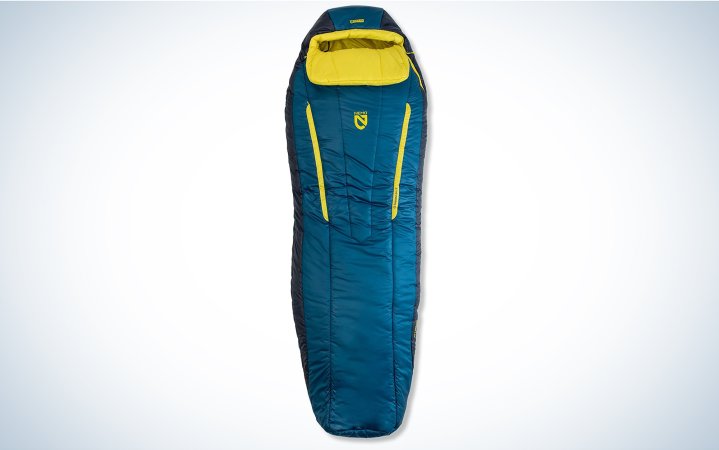
Buy the Forte
Key Features
- Sizes: Regular and long in both men’s and women’s
- Temperature Ratings: 20 and 35 degrees
- Weight: 3 pounds, 7 ounces (men’s regular 20 degrees)
- Packed Size: 18 x 9.5 inches in diameter
- Uses synthetic insulation
Pros
- Fully recyclable at end of life
- Very warm
- Modified mummy shape is comfortable
- Vents can be used for warmer conditions
Cons
- Bulky packed size compared to down bags
- Too heavy for most backpackers
While there has, naturally, always been interest in eco-friendly materials and manufacturing practices in the outdoor manufacturing space, Nemo has pushed things to the next level with their Forte Endless Promise Sleeping Bag. While other backpacking sleeping bags boast small percentages of the sleeping bag that are recyclable, this sleeping bag can actually be recycled. That means that at end of life you can send it in and it’ll be returned to its elemental parts and turned into new products in turn, rather than ending up in a landfill. (The liner and shell of the bag are also made from recycled materials, too, for good measure.)
The eco bonafides are impressive but how does this sleeping bag perform in the field? I’ve used this bag several times over the course of summertime car camping and, if anything, I found this bag to be too warm — even when the vents were pulled down. If you run warm, this is a great choice for shoulder season camping. I also shared this sleeping bag with a woman who runs cold (as part of a test-case scenario to see how important high R value pads are compared to higher temperature rated sleeping bags). She reported feeling very comfortable on a Memorial Day camping trip that saw temps drop down into the upper 40s. If you sleep cold and are looking for a warm and comfortable bag for your camping adventures, this is a great choice that is also great for the planet. —Laura Lancaster
Best Budget Synthetic: Marmot Trestles
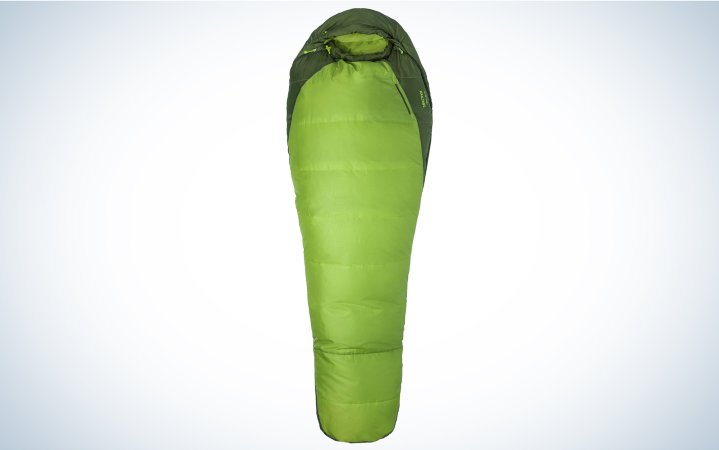
Buy the Trestles
Key Features
- Sizes: Regular and long in both men’s and women’s
- Temperature Ratings: 15 and 30 degrees
- Weight: 3 pounds, 7.7 ounces (women’s regular 30 degrees)
- Packed Size: 19 x 9 inches in diameter
- Uses synthetic insulation
Pros
- Wide footbox
- Full length two-way zipper
- Stash pocket
- Included stuff sack
Cons
- Heavy
- Doesn’t pack down very small
I purchased this sleeping bag on sale for $90 for my first foray into backpacking. It’s been a trusty sidekick and source of comfort since… I’m getting misty eyed already. The reason this is the best budget synthetic bag is because it’s very cheap and not that heavy. Even not on sale, it’s always affordable. There’s a wide footbox that doesn’t feel constricting to new backpackers. It also has a partial one-way zipper on one side and a full length two-way zipper on the other (you get to pick which sides). This allows you to vent, relax, and reach out pretty freely. This is especially good for new hikers that should feel like their bag is a home away from home, not a straitjacket.
While you can wrestle it into the included stuff sack, it doesn’t pack down as small as others on this list. But most beginner backpackers looking for a budget synthetic sleeping bag will be able to fit it into their kit. The stash pocket and no-snag zippers are nice advantages and the synthetic fill will still keep you warm in damp conditions or if it gets wet. —Ashley Thess
Best Deluxe: Western Mountaineering AlpinLite
Buy the AlpinLite
Key Features
- Sizes: Small, medium, large, and extra-large in unisex sizing
- Temperature Rating: 20 degrees
- Weight: 1 pound, 15 ounces for a medium
- Packed Size: 8 x 15 inches
- Uses 850fp RDS-certified down
Pros
- Available in a wide range of heights
- Comfortable width for users across a range of body types
- Made in the USA
- Great warranty
Cons
The Western Mountaineering AlpinLite might be pricey, but it more than delivered the goods as far as our tester was concerned. “I could immediately tell I was sleeping in a premium bag,” Diana Helmuth said. “Like a top tier duvet — silky, lofty, deliciously warm.”

Laura Lancaste
Helmuth did experience some condensation, inside a single-wall DCF-style tent, on a 40-mile trek through the Goat Rocks Wilderness, which impacted the sleeping bag near the footbox. This was especially noteworthy, as Western Mountaineering does not use hydrophobic treatments on the down in their products. Here’s their explanation for not treating down:
“We have found in our own testing that the performance enhancements of hydrophobic treatments on high quality down are widely overstated. High quality untreated down already has naturally water repellant oils on it left by the geese (makes sense since geese spend a lot of time in water). These oils help repel water and keep down lofted. More importantly is that these oils last indefinitely. Hydrophobic treatments wash out like a DWR and remove the natural oils during the application process. Because of this, and the water resistant capability of our shell fabrics, we feel that hydrophobic down does not provide a considerable impact on performance and could actually inhibit performance over the lifetime of our products.”

Diana Helmut
While actual submersion might be a different story, our tester was impressed with how the Western Mountaineering AlpinLite handled condensation. “I never felt it,” Helmuth reported. “It dried in the sun in less than a minute.”

Laura Lancast
Really the only issue with the Western Mountaineering AlpinLite is that, per our tester, it ran slightly colder than expected — more in line with the 25 comfort rating it has per the EN test Western Mountaineering had run on it (scroll down on their FAQs for more info on this). On our coldest night of testing, Helmuth shook out the bag to redistribute the down, saying it made the bag feel 10 to 15 degrees warmer. —Laura Lancaster
Best Ultralight: Feathered Friends Egret and Swallow
Buy the Egret (Women’s)
Buy the Swallow (Unisex)
Key Features
- Sizes: Small and medium in women’s, regular and long in unisex
- Temperature Ratings: 20 and 30 degrees
- Weight: 1 pound, 11.2 ounces for a women’s medium
- Packed Size: 9 liters
- Uses 950fp RDS-certified down
Pros
- Smaller size means a better fit, less expense, and less weight for smaller individuals
- Made in the USA
- Great warranty
Cons
- Slipped off of the sleeping pad easily
- Lost a few feathers during our testing trip (not from a tear)
- Expensive
Patrice “Steady” La Vigne tested the Feathered Friends Egret on a group testing trip through the Goat Rocks Wilderness, and raved about its comfort and warmth. Impressive, given that this was the lightest backpacking sleeping bags we tried out during a 40-mile trek that saw serious winds at elevation.

Laura Lancaster
“The 20-degree Egret was cozy and snug,” said Steady. “I liked that the two-way zipper allowed for temperature regulation. I slept with it unzipped from my feet to my waist most nights.” Steady noted that, even though it wasn’t a roomy bag, there was still plenty of room for side sleeping. “I slept comfortably inside even with my tossing and turning, and did not get all twisted in the bag.”

Patrice “Steady” La Vigne
Smaller details were also appreciated on the Feathered Friends Egret. The hood was “form fitting and super snuggly,” and the zipper was draft free, even on the windiest night of our test. It packed down to the size of a loaf of bread. —Laura Lancaster
Read Next: The Best Ultralight Sleeping Bags
Most Durable: Mountain Hardwear Yawn Patrol
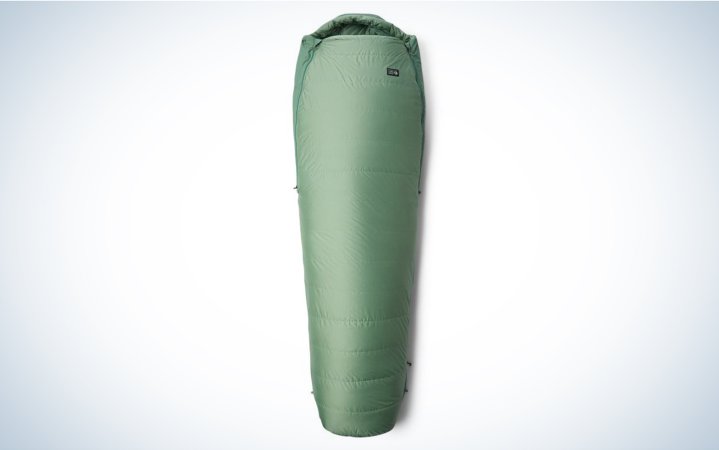
Buy the Yawn Patrol
Key Features
- Sizes: Regular and long
- Temperature Ratings: 15 and 30 degrees
- Weight: 2 pounds, 12.3 ounces (regular 15 degrees)
- Packed Size: Not available
- Uses 650fp RDS-certified down
Pros
- Durable
- Roomy
- Footbox opens completely
- Two two-way zippers
Cons
- Smells like down
- No compression sack
- Interior stash pocket is too small for a phone
This is a unique and highly functional backpacking sleeping bag. If the snug Parsec is overly filled with 850fp down, I’d say the very roomy curved rectangular Yawn Patrol is slightly underfilled with 650fp down. But this bag stays plenty warm thanks to the ample room for speedy lofting. And it’s great for side sleepers, though it doesn’t pack down very small. The 45 denier nylon ripstop bottom is highly durable. Compare that to the Parsec’s 20 denier recycled nylon shell. I wasn’t uneasy about dragging this bag out of my tent to look at the stars on a flat rock or field of dry grass. A lighter weight 30 denier nylon ripstop is used for the top shell fabric and the inside has a nice feel. This bag does smell like down, even after washing.

What’s really special about this bag is the dual two-way zippers and footbox zipper. The footbox opens completely, for venting purposes, but also if you want to wander out of your tent for breakfast still snug in your sleeping bag. The two-way zippers on both sides even enable you to stick your arms out or wear this bag like a cape or extra long parka. The hood is a little too small and the interior envelope pocket is half the size of a phone, but this is a fun and functional bag that weighs less than I would expect. —Ashley Thess
Best for Side Sleepers: Nemo Disco
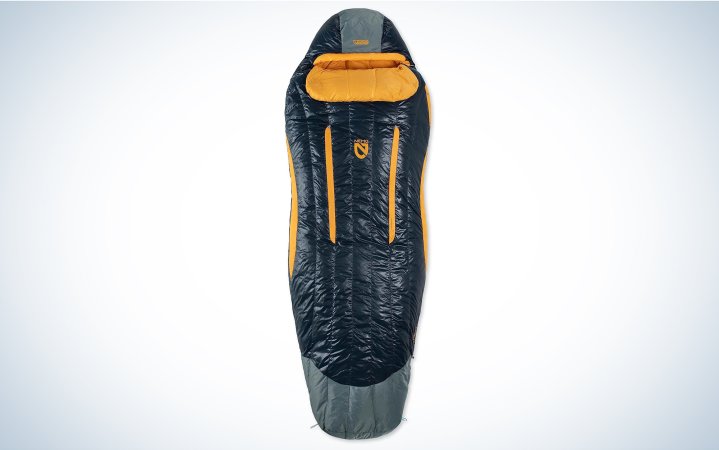
Buy the Disco
Key Features
- Sizes: Regular and long in men’s and women’s
- Temperature Ratings: 15 and 30 degrees
- Weight: 3 pounds, 1 ounce (women’s regular 15 degrees)
- Packed Size: 12.5 x 8.5 inches in diameter
- Uses 650fp PFAS-free hydrophobic, RDS-certified down
Pros
- Venting gills
- Included compression sack
- Spacious spoon shape
Cons
The Nemo Disco has a unique spoon shaped design to allow for more room near your elbows and knees. If you struggle with mummy-shaped backpacking sleeping bags but are looking for more weight savings than a rectangular bag, this (or one of the best backpacking quilts) is your answer. While roomy in these areas, you will not appreciate this shape if, like me, you tend to raise your knees to sleep. This is the thinnest part of the bag, and doesn’t allow you to curl into a ball very well. This bag is plush and soft, with snag-free zippers and a cozy oversized draft collar.

If you do get hot, there are Thermo Gill vents, 19-inch zippers on the chest that expose a section of un-insulated fabric for increased breathability. The pillow pocket might be too small for most inflatable backpacking pillows, but if you plan to just ball up your puffy or have a foam pillow, it’s great. There’s also a zippered stash pocket on the exterior that’s pretty tiny. The downside of all that extra elbow room, is some extra weight. If you don’t mind the weight, it’s plush and comfortable with the padding side sleepers crave. —Ashley Thess
Best for Cold Weather: Stone Glacier Chilkoot
Buy the 15-Degree Chilkoot
Buy the 0-Degree Chilkoot
Key Features
- Sizes: One size fits most
- Temperature Ratings: 0 Degrees and 15 Degrees
- Weight: 2 pounds, 3 ounces
- Packed Size: 7 x 15 inches
- Uses 850fp RDS-certified down
Pros
- Soft material
- Pillowy draft collar with a gentle magnetic closure
- Generous bill on a roomy hood
- Plenty of room for side sleepers
- Great warranty
Cons
- Confusing zipper
- Noticeably heavier than advertised
- No option available for warmer conditions
- Only one height available that is not appropriate for shorter individuals
Too often cold-weather sleeping bags compromise interior space to keep the weight down. Not only is this annoying for side sleepers, but it can make it tough for heftier individuals to squeeze inside at all. This made the Stone Glacier Chilkoot, which was one of the widest backpacking sleeping bags we’ve tested, all the more impressive.

Laura Lancaster
Adam Tycaster, who tested the Chilkoot on a 40-mile trek through the Goat Rocks Wilderness, was also impressed by how comfortable this sleeping bag was. “It felt silky and soft,” he said, noting that it had a, “full hood that encircles the face and felt pillowy at the brow.” One detail that stood out on the Stone Glacier Chilkoot was the magnetic closure for the draft collar, which made it easy to open and close.
The only confounding part of the Chilkoot sleeping bag for our tester was the two-way zipper. While sleeping bag zippers typically run up along the left or right edge, on the Chilkoot, it forms more of an arc, starting closer to top center of the bag near the user’s knees, arcing out to the side, and then curving back in where it zips up to the neck. In the field, Tycaster found that he was struggling to zip and unzip the bag — especially when he had rolled onto his side and gotten twisted up in the middle of the night.

Laura Lancaster
Men who are on the shorter side should also note that the Chilkoot is only available in one length. Sleeping bags that are excessively long may feel colder, as there is more excess air in the bag that needs to be warmed up. —Laura Lancaster
Looking for other options? Check out Outdoor Life’s overview of the best cold-weather sleeping bags.
Big Agnes Roxy Ann 3N1 and Lost Ranger 3N1
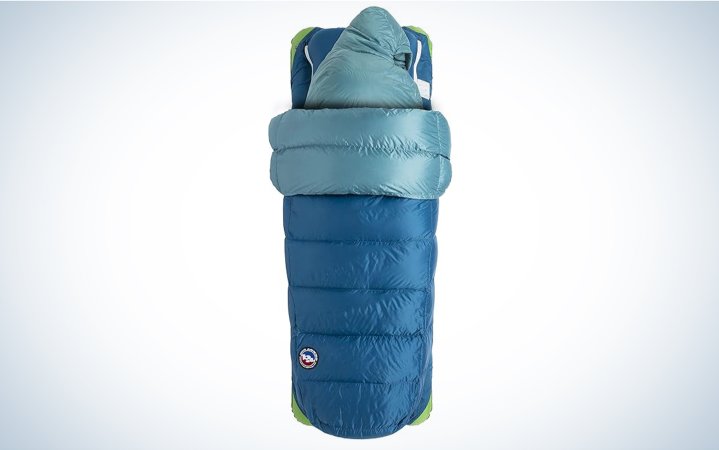
Buy the Roxy Ann (Women’s)
Buy the Lost Ranger (Men’s)
Key Features
- Sizes: Regular and long (both sizes available in women’s too)
- Temperature Ratings: 15 and 30 degrees
- Weight: 3 pounds, 5 ounces (women’s regular 15 degrees)
- Packed Size: 10.5 x 9.5 inches in diameter
- Uses 650fp DownTek
Pros
- Three bags in one: 50, 30, and 15 degrees
- Pad cinch system
- So warm
Cons
- Bulky when used all together for 15 degrees

The Big Agnes Roxy Ann 3N1 has a 50-degree, roomy rectangular quilt with an attached sheet. The bottom of the sheet cinches onto your sleeping pad. This keeps you on your sleeping pad and you don’t have to be directly touching the pad; plus there’s a pocket to hold your pillow. Then, there’s a snug, hooded mummy bag rated for 30 degrees that fits inbetween the sheet and quilt. This 3N1 system kept me on top of my pad and it was very warm with the right R-value pad.

But let’s break down the functionality of a 3N1 system. A 50-degree quilt is a risky decision to me. I’d likely never bring just that backpacking where I live. Whether it’s the mountains or the desert, nights are chilly regardless of the season. And since it’s attached to a sheet, it’s not a functional blanket either. The 30-degree bag is something I would bring backpacking, but this particular one is very snug; I certainly woke up in a claustrophobic panic a few times. Also, the off-center, but not quite to the side zipper was disorienting. I struggled to find it in the dark when I needed it and sometimes I found it unexpectedly and thought I was turned cattywhompus in the bag, ensuing more straitjacket panic. The zipper tends to get stuck a lot, which doesn’t help.
However, when this system is all together, it’s great: warm, cozy, and versatile. You can unzip the bag’s full length two-way zipper to vent while still retaining heat underneath the quilt. The only issue here is, there are other bags and quilts that are just as warm, for a similar price, that are much lighter and less bulky. So the versatility of this system really comes down to where you’re backpacking and your typical sleep temperature and habits. —Ashley Thess
Best for Babies and Toddlers: Morrison Outdoors Little Mo 20
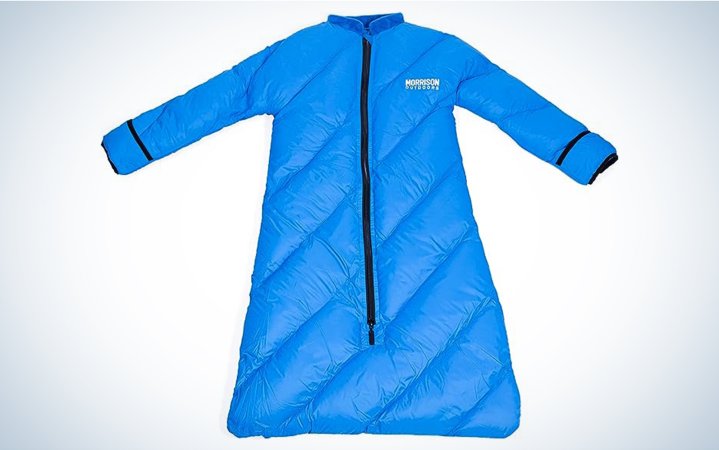
Buy the Little Mo 20
Buy the Big Mo 20
Key Features
- Sizes: 6 months to 2 years (larger models available for older tots)
- Temperature Ratings: 20 and 40 degrees
- Weight: 9 ounces
- RDS-certified down fill (20-degree bag), synthetic fill (40-degree bag)
Pros
- Designed with safe sleep practices in mind
- Your child stays warm no matter where they throw themselves in the tent
- Available in limited colors including red, green, blue, and purple
- Lightweight
Cons
Before Morrison Outdoors came along, a lot of parents of babies and toddlers were stuck co-sleeping if they wanted to make sure their kiddo was warm in the backcountry. There just weren’t real options out there for the under 3 set.

The Morrison Outdoors Little Mo changed that. The first time we used this while camping with our kid she slept straight through the night; I woke up to her throwing herself gleefully onto my chest at dawn with a wide smile on her face. She was delighted. I was delighted. We used that sleeping bag for the next two years, upgrading her to the Big Mo as we went along.
Read Next: The Best Kids Sleeping Bags
At one point, we even took her on a 30-mile trek in Mount Rainier National Park where she slept at elevation. The 20-degree version of this bag kept her plenty warm. When she finally outgrew hers (word to the wise: the arms can end up being too short before the actual length), we were all devastated. Fortunately, you don’t have to be: Morrison Outdoors has since come out with an even larger size: the Mighty Mo. (And a parent bag to match, the Mega Mo.) —Laura Lancaster
Things to Consider Before Buying the Best Backpacking Sleeping Bag

Sleeping Pad
Reviews of sleeping bags are littered with complaints that they weren’t warm enough or didn’t live up to the temperature rating, but unfortunately these reviews mean nothing if you don’t know what R-value sleeping pad they were using. That’s because sleeping bags will not perform up to their temperature rating unless they are paired with a sleeping pad that has an R-value of 4 or higher.
Read Next: The Best Backpacking Sleeping Pads
An R (for resistance) rating measures how well a sleeping pad prevents (or resists) the cold of the ground from creeping through to the side you are sleeping on. Low R values provide little to no resistance while high R values resist even subfreezing temperatures.
Read Next: What is R Value? It’s Why Your Sleeping Bag Doesn’t Keep You Warm
Temperature Rating for the Best Backpacking Sleeping Bags
The first thing you need to know about a sleeping bag’s temperature rating is that there isn’t going to be just one number: There is a “comfort” temperature, a “lower limit” or “transition” temperature, and a “risk” or “extreme” temperature. The comfort number is what it sounds like — this is the temperature at which you’re the most likely to actually be comfortable. The “limit” or “transition” temperature is when you will start to feel uncomfortable — you’re not shivering necessarily, but you’re not sleeping well either. The “risk” temperature is the temperature at which you are in danger of hypothermia.
The tricky part is that the advertised temperature rating for a sleeping bag is sometimes the comfort temperature and sometimes the transition or lower limit rating. Women’s bags are more likely to list the comfort temperature rating, as opposed to the limit rating (manufacturers generally assume that women run colder than men), but this varies by brand: Always check the fine print before committing to a purchase.
The good news about these temperature ratings is that they aren’t based on the personal opinions of the manufacturers — there is an actual standard that the temperature of a sleeping bag is judged on (two, in fact). Sleeping bag temperature ratings are assessed using a heat-producing manikin with temperature sensors placed inside of a climate controlled room on top of a 4.8-R rated sleeping bag — I’m vastly paraphrasing here, but you get the idea of what an intense process this is. The upshot of all this effort on the part of the sleeping bag manufacturers is that if you know your ISO-rated or EN-rated 30-degree bag is the right temperature for you, you can be reasonably confident in purchasing a 30-degree bag from a different manufacturer.
The downside is that the temperature ratings are just that: ratings. Human bodies are different, and only you know if you are cold, hot, or surface-of-the-sun hot. If you run cold, go with at least 10 degrees warmer than you think you need. —Laura Lancaster
Gender
Most of the time, the difference between a men’s sleeping bag and a women’s sleeping bag is just about the size and shape (and, too often, the color), but sometimes there are differences in where and how the bag’s insulation is concentrated to reflect the differences in how men and women dispel heat. The advertised temperature rating is also typically a comfort rating for women’s bags and a limit rating for men’s bags. —Laura Lancaster
Fill for the Best Backpacking Sleeping Bags

I’ll be honest with you; backpackers can debate the down versus synthetic fill of sleeping bags until they’re blue in the face. If you’d like to get to know the intricacies of this valid debate, by all means, dive in: Down vs Synthetic Sleeping Bags. But I’m going to lay it out from a practical buyer’s standpoint.
Read Next: Primaloft vs Down
Down is superior in its warmth to weight ratio, but it’s also more expensive. Down detractors will say that it won’t perform when wet and there are environmental concerns about the treatment of the animals it comes from. In reality, most (be sure to check) down bags are treated to be hydrophobic. This treatment can wear off, not all treatments are created equal, and it will require a special detergent to preserve this hydrophobic quality. But it works. There is also a Responsible Down Standard certification that signifies responsibly sourced down. I highly encourage you to verify an RDS-certification before purchasing any down product.
Synthetic is cheaper and performs when wet, no treatment necessary.
Read Next: How to Choose a Sleeping Bag
FAQs
If you sleep cold, I would check out the women’s version of a sleeping bag. Sometimes the insulation is tailored to where women typically get cold and how they dispel heat. The advertised temperature rating of a women’s bag is also usually a comfort rating, rather than a limit rating for men’s bags. All of this to say, women’s bags are usually warmer.
Another consideration is if you’d like the opportunity to zip your bag onto your partner’s bag to create a double. Some companies offer this possibility, but only in opposite gendered bags. Other times, the difference between a men’s sleeping bag and a women’s sleeping bag is just about the size and shape (and, too often, the color). So check the measurements and select whatever bag suits your needs, regardless of gender.
The sleeping bags on this list range from $100 to $600. If you’d like to spend less, consider the budget options. Usually synthetic bags are cheaper, and also heavier. The ultralight bags will typically be the most expensive.
That depends on how hot or cold you sleep, location, and season. If you sleep cold, go with a rating 10 degrees colder than you think you’ll need. Take into account comfort and limit ratings. Base your selection off the comfort rating and the average nighttime temperatures you’ll be using it in. Also, be sure to have a properly rated sleeping pad to take advantage of the full temperature rating.
Final Thoughts on the Best Backpacking Sleeping Bags
The best backpacking sleeping bag is a big investment and a vitally important piece of gear. If you don’t get a good night’s sleep, it’ll make hiking the next day much less enjoyable. And if your bag isn’t up to the conditions, it can be downright dangerous. After backpacking with all of these bags, we’ve noted their best use cases, advantages, and disadvantages to inform your decision.
Read the full article here

